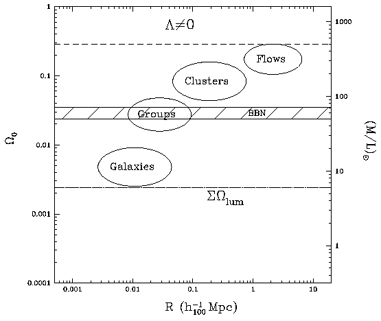


4. WHAT WE DON'T KNOW ABOUT DARK MATTER
The nature of dark matter is the critical unresolved issue in cosmology.
On the scale of individual galaxies, the evidence for dark matter is
incontrovertible (for a review, see
Ashman 1992).
From kinematic studies
on cosmological scale, two conclusions emerge, as illustrated by
Figure 3.
Clusters show dark matter in excess of the plausible upper bound from
nucleosynthesis, indicating that most of the dark matter is nonbaryonic
(Bahcall, Lubin, &
Dorman 1995).
Structure formation theories would
require this dark matter to be non-relativistic at the epoch of recombination,
or ``cold.'' This in turns implies a particle physics solution to a cosmology
problem, with no experimental data to guide us at this time. Second,
cluster evolution and mass-to-light ratios point to a value of  0
well below one (setting aside for a moment the ambiguous results from
large scale bulk flows). If this is true, then the spatially flat universe
that is a natural consequence of the inflationary big bang model can only
be recovered with the addition of a non-zero cosmological constant.
Unfortunately, we have no theoretical expectation for why
0
well below one (setting aside for a moment the ambiguous results from
large scale bulk flows). If this is true, then the spatially flat universe
that is a natural consequence of the inflationary big bang model can only
be recovered with the addition of a non-zero cosmological constant.
Unfortunately, we have no theoretical expectation for why  should have a cosmologically interesting value. Few people are willing
to contemplate a deeper level of ignorance concerning our theory of gravity,
yet there are puzzling problems in the dynamics of galaxies that deserve
continued attention
(Milgrom 1989;
McGaugh & de Blok 1998).
should have a cosmologically interesting value. Few people are willing
to contemplate a deeper level of ignorance concerning our theory of gravity,
yet there are puzzling problems in the dynamics of galaxies that deserve
continued attention
(Milgrom 1989;
McGaugh & de Blok 1998).

|
| Figure 3. The density of matter on different scales. The
dot-dashed line indicates the integral over luminous matter in galaxies
and the striped
region shows the baryon bounds from big bang nucleosynthesis.
|



 0
well below one (setting aside for a moment the ambiguous results from
large scale bulk flows). If this is true, then the spatially flat universe
that is a natural consequence of the inflationary big bang model can only
be recovered with the addition of a non-zero cosmological constant.
Unfortunately, we have no theoretical expectation for why
0
well below one (setting aside for a moment the ambiguous results from
large scale bulk flows). If this is true, then the spatially flat universe
that is a natural consequence of the inflationary big bang model can only
be recovered with the addition of a non-zero cosmological constant.
Unfortunately, we have no theoretical expectation for why  should have a cosmologically interesting value. Few people are willing
to contemplate a deeper level of ignorance concerning our theory of gravity,
yet there are puzzling problems in the dynamics of galaxies that deserve
continued attention
(Milgrom 1989;
McGaugh & de Blok 1998).
should have a cosmologically interesting value. Few people are willing
to contemplate a deeper level of ignorance concerning our theory of gravity,
yet there are puzzling problems in the dynamics of galaxies that deserve
continued attention
(Milgrom 1989;
McGaugh & de Blok 1998).



